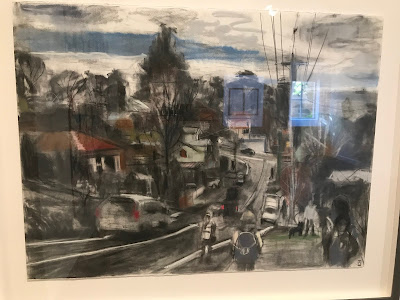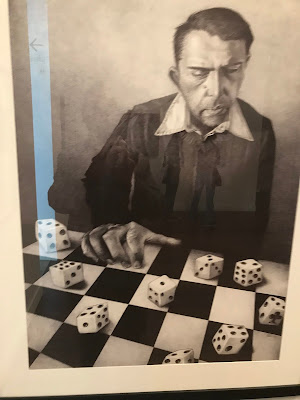I was at the National Art School the other day to pick up a friend of mine who studies there and popped in to see the hang in the exhibition space. The Dobell Prize announcement had been a couple of weeks earlier and I had actually been there on the night but the crowds kept me out of the salon. I saw Craig Waddell – some of whose drawings are in what follows – but didn’t introduce myself. I’ve met Craig before because I’ve bought some of his drawings, which are now in my own collection.
In fact Craig’s drawings are right near the front door. There are a couple of dozen of them (see below) and of course they are fabulous – but I can’t recommend him too highly as I’m biased (for obvious reasons).
Another collection of drawings won the prize (see below). These are by Euan Macleod, and show a tropical locale much like the Sunshine Coast where I lived from 2009 to 2015. In this case it’s the border of NSW and Queensland but you get the same mix of suburban normalcy and vegetable originality that you get further north in Maroochydore. I didn’t like the small town feel of the place and never really got to know anyone apart from people working in shops. I mostly socialised with my mother Judith and her housekeeper Georgette.
Macleod’s lovely little sketches are fresh and lively but there is a weight behind them, which anchors the ephemeral intimations of space, light and colour – even movement – that each of his 15 drawings embodies. As in the case of Waddell’s entry the multiplicity of images adds substance and importance and counterbalances the fragmentary nature of the line making.
I’ll deal with another heavyweight immediately, in this case John Bokor’s ‘The Lounge Room in Spring’. Bokor exhibited recently in Brisbane and his paintings are also lovely – but grand and aspirational, like this discrete charcoal drawing of an interior. Dangerously unstable, charcoal can be dramatic and expressive in the right hands, as it is here. You feel the space and can almost smell the light coming in through the windows of the room pictured.
One drawing that caught my eye for its delicacy of execution and for the conventionality of its subject matter is Anh Nguyen’s ‘School route, against the sun’ (see below). You can almost hear the cars moving along the carriageway when you stand in front of this piece of art. And the shimmering clouds, bathed in the sun’s refulgence, speak of lost afternoons when cares press on your mind and you have to get home.
Nearby was Stephen Bird’s ‘Man Cooking Eggs on a Fire’ (see below).
There’s something of Reg Mombassa about this drawing, with its crazy camper, replete with hat-strung fly net, his stick in his hand (communing with nature), and a gnarled gum tree poking its straggly arms across the canvas.
There was actually a work by Mombassa in the hang (see below), ‘Rockfaces and bush above Coledale’. Normally, this artist signs such figurative works with his real name – Chris O’Doherty – but in this case he’s gone with his more conspicuous nom de plume. Like his other figurative works, this drawing is both self-contained and expansive. You are constrained by the arbitrary and rigid “frame” the artist has sketched in to encapsulate the work, but the play of colour and of line transports you to another place. It’s like a Victorian diorama, or one of those microscopic images you put up before your eye so that you can be taken in imagination to the Taj Mahal or to Mount Rushmore.
More rocks are visible in GW Bot’s ‘The Oracle’ (see below), a drawing made from graphite. Something in this drawing of the Chinese love of rocks.
Another figurative genius is evident in Brian Martin’s ‘Methexical Countryscape Paakantyi #18’ (see below). Made on a number of abutting sheets of heavy paper, this charcoal drawing, like Bokor’s, is saturated with the bright Australian sunshine. The strange title can’t entirely drag you away from the native bush, and you almost smell the eucalyptus oil, hear the cicadas chirring in the branches of the trees above you.
Amy Dynan’s ‘Set wide the window’ (see below) also uses nature as subject matter, this time clouds. This work is made from pastel and charcoal.
Joshua Charadia’s ‘Peripheral View 56’ is also made from charcoal (see below) but the subject matter is insistently man-made. If you ignore in the photo the two people standing near the doorway you can see Charadia’s dense strokes forming a heavy, though blurred matrix of lines that bleed together. Yet even though the material is so concrete there’s something transitory about the ensemble, as if the building and the road pictured could be wiped away as easily as wiping away a mark from a sheet of paper.
Next in my review is Matt Bromhead’s ‘Thirty Views West’ – like Dynan’s work, made from charcoal and pastel – which is a quilt of abstract marks that speaks of collective power and agency. You can’t feel claustrophobia in this work – or can you? – but, rather (or so it seemed to me) a kind of appropriateness emerging as a result of the proximity of all the marks on the paper. Such a fragile thing, yet so enduring! Life!
Minka Gillian’s ‘The Origin of the World’ (after Courbet)’ has a specific painting in mind that it is quoting. You feel the crowd also in this work, in this case the generations of women who have come to make their mark following the progressive movements of the past century. This work is made from ink, acrylic and pen, and it is also made on paper.
Another busy work by another woman, ‘Dust and Metal’ – Anna Mould the artist – shows a car but one fragmented by a dense matrix of pearly colours, as though seen through water. But the materials used for this work are merely ink and coloured pencil. I imagine that some form of stencil was used to make the grid of squares that form the counterpoint to the figurative mode belonging to the car. This is a very impressive work, and one that I imagine was quite difficult to make.
Another tricky work is Leonardo Uribe’s ‘Immigration Form 80 Page 3’. Tricky because made from human hair stuck down on paper with glue. What’s so clever in this case is the sensation of fear that such documents convey to the person who must fill them out. A person applying for residency, say, or for a bank loan. The confluence of the personal and the impersonal being rendered in graphic form here, on a sheet of paper. Fascinating.
Fiona White’s ‘Debutante’ (see below) is colourful, unlike most of the works on display, and contains a tension between the conventionality of the title and the garishness and vigour of the swatches of pigment – oil stick and lacquer – that have been formed across the board used to ground the work. There’s something delicate being expressed here, a reticence and unwillingness to conform, yet it is done with such vibrancy and relish for the artist’s historical ability to shock.
Another portrait is Noel Thurgate’s ‘Portrait of Kevin Norton’. This image speaks for itself. Delicate yet profound.
A man’s face is also the subject of Maria Petrova’s ‘It’s Just a Game’ (see below), where the distortion of the forms is echoed beyond the realm of the knowable to rope in dimensions unseen in the image itself. Perhaps this drawing speaks about your own life?
Faces appear also in Jumaadi’s ‘Twenty twenty’, a large chinagraph work (see below). This is wax pencil on paper. There’s something here about population density that is allied to powerlessness. Disturbing and beautiful.
Paul White’s ‘Cosmic debris (remnants in time)’ (see below) also uses density in the depiction of the subject matter. In this case, dried roses. A hint of the antique is seen here, the kind that you glimpse at a second-hand shop where you can pick up someone’s old teapot for $2. Something commonplace rendered in exquisite detail.
Lemons are on offer in Mitch Cairns’ ‘Taste Etc … (2 & 7)’, which is a linocut with collage and pastel. A lovely concentration of tone and texture in a dance of masses and hues.
Jackson Farley’s ‘every kingdom was born to die’ (see below) also plays with the ephemeral nature of existence, this time not by depicting perishable items such as flowers and fruit, but by showing clouds. In his pigment print the artist has made meaningful marks on the sky. You can see things that you recognise among the wisps of vapour that lie ragged across the firmament. You can almost hear the generations groaning as you stand in front of this work made on cotton rag.
History speaks also in a nearby work, Martin King’s ‘strangerlands 1’, which is graphite, gouache, gold leaf on drafting film, as well as watercolour. Another paper work – most of the works in this show use this medium – the scale of this item is astonishing. It takes up a whole section of wall and towers over the viewer.
Anthony Cahill’s ‘Love Song’ (see below) is, on the other hand, diminutive and unshowy. Man’s relationship with the natural world is rendered in this charcoal pencil, soft pastel and water work on paper.
Another work that embraces the border between the man-made and the natural is Damian Dillon’s ‘(dis)integration #10’, which is oil stick, pencil and texta on dye sublimation print. Mounted on aluminium, this work has a metal sheen about it that speaks of humanity but the subject matter is determinedly ecological.
























No comments:
Post a Comment